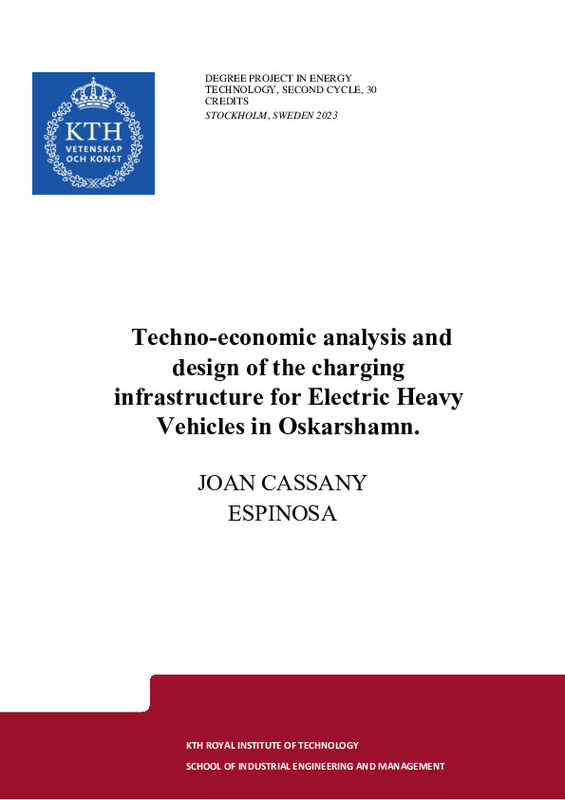|
Resumen:
|
[EN] Within the most pollutants industries, the energy sector is the most significant contributor to
climate change, representing two-thirds of the total Greenhouse Gas (GHG) emissions. One of
the main responsible for ...[+]
[EN] Within the most pollutants industries, the energy sector is the most significant contributor to
climate change, representing two-thirds of the total Greenhouse Gas (GHG) emissions. One of
the main responsible for these emissions is transportation, which accounts for 26% of the world’s
energy consumption, with crude oil-derived products providing more than 90% of this energy. In
Europe, the transport sector is the only sector that has experienced an upward trend of GHG
emissions between 1990 and 2017, opposite to all others, such as agriculture, residential, or
industry. To cut these growing GHG emissions, transport electrification has been presented as a
potential and promising solution for decarbonization thanks to the no tail-pipe emissions and the
possibility of using renewable energy to power them. One particularly interesting segment of the
transport sector is Heavy Duty Trucks (HDTs) used for freight transport. HDTs are the backbone
of the Swedish economy and competitiveness since they represent 45% of its total goods
transportation. However, the Swedish transmission grid needs to evolve parallelly to cope with
the increase in electricity demand and withstand the Charging Infrastructure (CI) necessary for
the electrification of HDTs. Oskarshamn is a Swedish municipality that presents a high potential
for electrification of its HDTs, which are currently operated with diesel. Therefore, the objective
of this Master Thesis is to study the implementation of Electric Heavy Vehicles (EHVs) CI in
Oskarshamn by collaborating with local interested stakeholders. The study is conducted through
an analysis of the current status of EHV technologies, as well as CI possibilities, which, together
with the information provided by truck operators from Oskarshamn, allows to perform a technoeconomic assessment of the solution and analyze the business model of its operation. A virtual
model is created with Python to simulate the actual operating conditions, which uses all the
information gathered and optimizes the CI design while fulfilling all its transport requirements.
Additionally, the study seeks to identify potential areas for shared ownership of the CI to increase
the project's feasibility. This project’s findings demonstrate that electrification of freight
transportation brings financial and sustainable benefits for truck operators while presenting a
diverse range of options to meet their specific transportation requirements. Furthermore, by
effectively negotiating ownership terms and electricity tariffs for CI, there is potential to further
enhance business profitability.
[-]
[VL] Dins dels sectors més contaminants, el sector energètic és, amb diferència, el que més contribueix, representant dos terços del total d'emissions de gasos d'efecte hivernacle (GEH). Un dels principals responsables ...[+]
[VL] Dins dels sectors més contaminants, el sector energètic és, amb diferència, el que més contribueix, representant dos terços del total d'emissions de gasos d'efecte hivernacle (GEH). Un dels principals responsables d'aquestes emissions és el sector del transport, que va representar el 26% del consum total d'energia mundial, amb productes derivats del petroli cru proporcionant més del 90% d'aquesta energia. A Europa, a diferència de la resta de sectors, el sector del transport és l'únic sector que ha experimentat una tendència a l'alça de les emissions de GEH entre 1990 i 2017. Per tant, l'electrificació del sector del transport és una solució potencial i prometedora per a la descarbonització, gràcies a la no emissió de GEH pel tub d'escapament i la possibilitat d'utilitzar energies renovables per alimentar-los. Un segment especialment interessant dins del sector del transport són els camions pesats (HDT) utilitzats per al transport de mercaderies. Els HDT són l'eix de l'economia i la competitivitat a Suècia, ja que representen el 45% del transport total de mercaderies. De igual manera, la xarxa de elèctrica sueca ha d'evolucionar paral·lelament per poder fer front a l'augment de la demanda d'electricitat i poder suportar la infraestructura de recàrrega (CI) necessària per a l'electrificació dels HDT. Oskarshamn és un municipi suec que presenta un alt potencial d'electrificació dels seus HDT que funcionen actualment amb gasoil. Per tant, l'objectiu d'aquest Treball de Fi de Màster és estudiar un cas real d'implantació de la CI per a vehicles elèctrics pesats (EHV) a Oskarshamn col·laborant amb les parts interessades del municipi. L'estudi es realitza mitjançant una anàlisi de l'estat actual de les tecnologies EHV, així com de les possibilitats de CI, que juntament amb la informació proporcionada pels operadors de camions d'Oskarshamn permet realitzar una avaluació tecnoeconòmica de la solució i analitzar el model de negoci del seu funcionament. L'estudi també busca identificar àrees potencials per a la propietat compartida de CI per tal d'augmentar la viabilitat de la seva implementació. Per simular les condicions reals de funcionament, s'ha creat un model de bessó digital (digital twin) amb python, que utilitza tota la informació real recopilada i optimitza el sistema al mateix temps que compleix amb tots els seus requisits.
[-]
|







